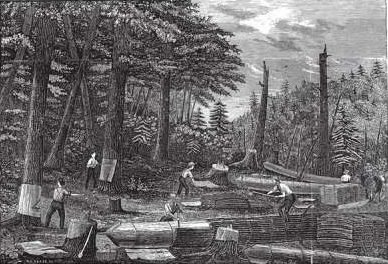An 1851 Fratricide Over Hemlock Trees


 In January of 1851, Mamakating, NY, resident William Palmer announced to two friends, James Larkin and Albert Squires, that he intended to kill his brother. The Sullivan County siblings had been at odds for quite a long time, but the declaration marked an escalation in the feud, and proved to be prophetic.
In January of 1851, Mamakating, NY, resident William Palmer announced to two friends, James Larkin and Albert Squires, that he intended to kill his brother. The Sullivan County siblings had been at odds for quite a long time, but the declaration marked an escalation in the feud, and proved to be prophetic.
William and Timothy Palmer had jointly purchased some land just south of the hamlet of Wurtsboro around 1850, and constructed separate homes just a short distance apart. Their brother Joseph and his family – his wife and three children – soon came to live with William, as did the three brothers’ father.
The leather tanning industry was then in full swing in the Catskills, and the Palmers’ land was rich with hemlock trees, the bark of which was an integral part of the tanning process. Timothy Palmer saw the wealth of hemlocks as a resource just waiting to be tapped, and quickly set out to convert the bark of the abundant trees into cash.
William had a very different idea about how to manage the property, believing that the trees should be left untouched. As equal partners in ownership of the property, the brothers began to argue over this difference of opinion, and their disagreements soon became more frequent and more violent.
“From being brotherly, they became enemies, bitter and malignant,” James Eldridge Quinlan writes in his 1873 History of Sullivan County. “Crimination and recrimination led to blows, and complaints for assault and battery, perjury, etc. William wished to preserve the timber and bark on the place, while the other persisted in cutting and peeling.”
As the arguments and physical altercations became more frequent, so too did the threats, and William more than once repeated the declaration he had made to Larkin and Squires in January that he was going to kill his brother.
On the afternoon of May 16, 1851, Timothy Palmer left his home after eating his dinner and made his way to the mountain to peel bark.
Sometime between two and three o’clock that afternoon, Joseph Palmer’s wife heard the sound of a gunshot from the woods, some screaming, and a dog barking. She then witnessed the little dog that belonged to William Palmer running from the woods.
When Timothy had not returned home by seven o’clock that evening, his wife became alarmed and decided to go look for him, enlisting the aid of a neighbor, Stewart Rafferty, who revealed to her that he had also heard the gunshot and the dog barking earlier in the day.
“[Rafferty] made a search for Timothy in the company of a son of the latter, and found him dead, with the trunk of a tree across his body,” Quinlan recorded. “Subsequent investigations proved he had been shot in the breast, the tree raised with a handspike, the body dragged three or four feet and placed under the tree, and the trunk lowered upon it in a way that was intended to create the impression that the murdered man had been killed by an accident. The blood on the ground where Timothy fell when he received his death-wound was carefully covered with leaves, and other things done to prevent suspicion.”
Upon discovering the body, Rafferty sent a messenger for Doctor John A. Taylor and Eli Bennett, one of the county’s Coroners. Sheriff James S. Wells was also summoned. The body was removed to William Palmer’s house, and when William saw his dead brother’s body, it is said that “he gazed on it unmoved and with an unchanged countenance.” He was soon taken into custody.
“He was searched,” Quinlan writes. “Nothing was found on his person to implicate him, but a pair of pantaloons which he had worn through the day, and left in an upper chamber, were brought down and found to be stained with blood. He declared that he did not know how it came there.”

 The Coroner’s inquest the next day found that “a quantity of shot had entered the body — one rib was severed, the left lung lacerated, etc.” Based on the circumstantial evidence against him — including the testimonies of Larkin and Squires that
The Coroner’s inquest the next day found that “a quantity of shot had entered the body — one rib was severed, the left lung lacerated, etc.” Based on the circumstantial evidence against him — including the testimonies of Larkin and Squires that
they had heard him threaten to shoot his brother – William Palmer was indicted, and went on trial in Circuit Court in September of 1851, Judge William B. Wright (1806-1868) presiding.
District Attorney Charles H. Van Wyck prosecuted, while George W. Lord was defense attorney. Quinlan records that the jury was made up of “Levi R. Lounsbury, Peter Ackley, Thomas Whipple, John D. O’Neill, William Young, Levi Barton, David R. Perry, Andrew Hardenbergh, Robert Stewart, John H. Clayton, David Smith, and George Adams.”
“After a fair and impartial trial, the prisoner was found guilty of murder and was sentenced to be hung on the 20th of November, 1851,” Quinlan writes. “The sentence was enforced on that day by Sheriff Wells.”
William Palmer never publicly confessed to murdering his brother, but during his hanging, Reverend James, one of the local clergymen in attendance, made known that a few hours earlier Palmer had told him he was guilty of the crime and that the punishment was just.
With his execution, William Palmer became the second man hanged in Sullivan County, and the first in the new Courthouse built following the fire of January 1844, which had destroyed the original building.
Read more about crime and justice in New York State.
Illustrations, from above: Hemlock trees being cut and peeled for tanning (courtesy Zadock Pratt Museum) Judge William B. Wright, later Chief Judge of the New York State Court of Appeals, presided over the murder trial of William Palmer.
Source link





